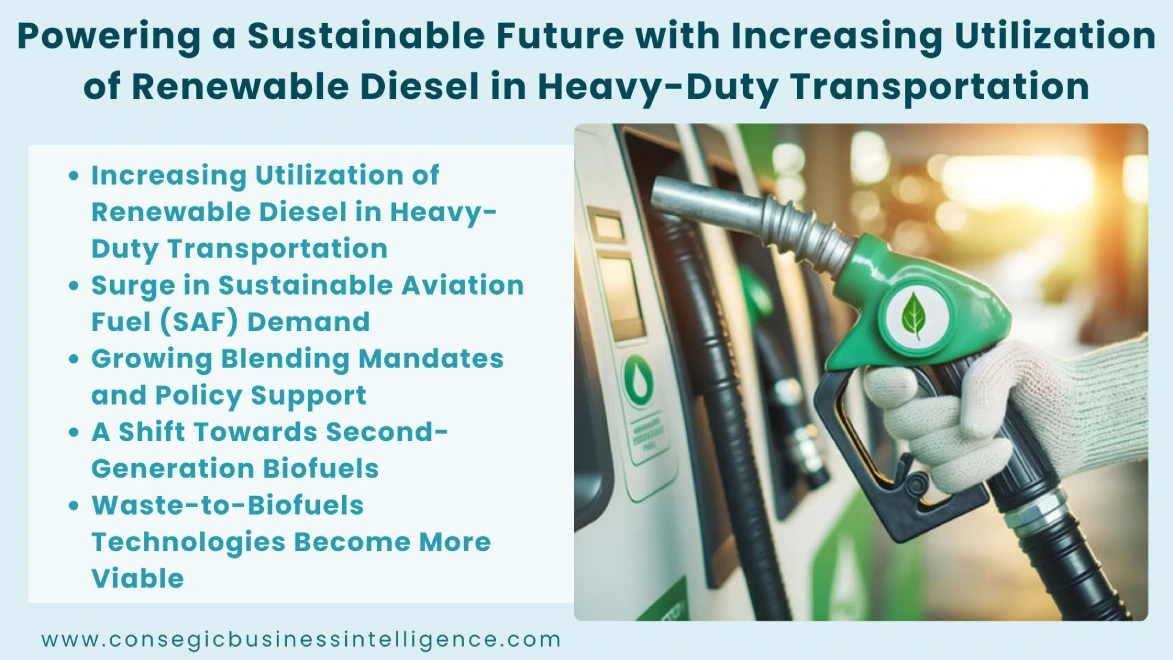Biofuel Market Trends 2025: Powering a Sustainable Future with Increasing Utilization of Renewable Diesel in Heavy-Duty Transportation
Category : Energy and Power | Published Date : May 2025 | Type : Press Release
As global awareness of climate change intensifies and the need for energy diversification grows, the demand for sustainable alternatives has reached unprecedented levels. Biofuels, offering a renewable alternative to fossil fuels, are central to meeting rising energy demands more sustainably. In 2025, the Biofuels market is witnessing significant shifts, fueled by increasing utilization of renewable diesel in heavy-duty transportation, surge in sustainable aviation fuel (SAF) demand, growing blending mandates and policy support, a shift towards second-generation Biofuels, and waste-to-Biofuels technologies becoming more viable. This article explores the key trends driving the Biofuels market in 2025 and how they are helping meet rising energy demands more sustainably and intelligently.

1. Increasing Utilization of Renewable Diesel in Heavy-Duty Transportation
One of the most transformative trends in 2025 is the increasing utilization of renewable diesel in the heavy-duty transport sector. Examples include heavy-duty trucks, trailers, crawler cranes, and oversized cargos, amongst others. Renewable diesel, a Biofuels, offers a readily available sustainable solution for long-haul trucking. It reduces greenhouse gas emissions compared to conventional diesel, contributing to a cleaner environment. It also allows for efficient operation and maintains the speed necessary for long-haul trucking.
It is also used as “drop-in fuel”, which means it blends well and is transported using existing infrastructure. This makes it a practical solution for immediate adoption. As decarbonization becomes essential in heavy-duty transport, the demand for these renewable diesels is rapidly escalating, pushing Biofuels manufacturers to expand production capacities. For instance, in 2025, leading manufacturers such as Neste, Valero, and TotalEnergies are actively scaling up their production.
2. Surge in Sustainable Aviation Fuel (SAF) Demand
The global push toward clean and decentralized energy is another major factor influencing the Biofuels market. The aviation sector accounts for roughly 2.5% of global carbon dioxide emissions. Owing to this, they are increasing their commitment to reducing carbon emissions and are opting for sustainable aviation fuel (SAF) as a decarbonization solution. SAF is a Biofuels alternative to traditional jet fuel. It is produced from renewable, non-fossil fuel sources such as biomass or algae.
Moreover, SAF is designed to be fully compatible with existing aircraft engines. This makes it a readily deployable solution. In 2025, airlines such as United Airlines, Inc, KLM, and JetBlue began integrating SAF into blends with conventional fuel. Additionally, companies such as Boeing and Airbus are actively promoting SAF use. Global demand for SAF is projected to increase significantly in the coming years. For example, by 2030, demand is expected to hit 10 MTPA, driving Biofuels demand.
3. Growing Blending Mandates and Policy Support
Governments worldwide are increasingly implementing and strengthening regulations. This aims to encourage the use of Biofuels and reduce reliance on traditional fossil fuels. For instance, the most recent U.S. EPA under Renewable Fuel Standard (RFS) program mandates blending of 20.94 billion gallons of Biofuels in 2023, 21.54 billion gallons in 2024, and 22.33 billion gallons in 2025.
Moreover, governments worldwide are providing tax credits and subsidies, which further enhance the economic attractiveness of Biofuels compared to fossil fuels. For example, India offers a capital subsidy of up to 30% of the total project cost to establish Biofuels production plants. As governments focus more on rising global temperatures, extreme weather events, and disruptions to ecosystems, they are investing in decarbonization solutions, creating potential for Biofuels.
4. A Shift Towards Second-Generation Biofuels
The Biofuels market is witnessing a significant shift towards second-generation Biofuels. This is driven by the need for more sustainable and efficient energy sources. First-generation Biofuels are produced from readily available food crops such as corn, soybeans, and sugarcane. However, second-generation Biofuels are produced from non-food biomass sources and lignocellulosic biomass such as agricultural residues (e.g., straw, husks, corn stalks, and others), forest residues (e.g., woody biomass, sawdust, and others), dedicated energy crops (e.g., switchgrass, miscanthus, and others), and cellulosic ethanol.
The main benefit of second-generation Biofuels is that they reduce competition with food crops and utilize waste materials. This promotes sustainability and the concept of biorefinery. Ongoing research and development are improving their conversion technologies. This reduces costs while increasing efficiency. Several companies are actively building new second-generation Biofuels plants, including Raizen, Bio-Oils & Cepsa, and Advanced Biofuels. This transition promises greater sustainability and a more circular approach to resource utilization in the Biofuels sector.
5. Waste-to-Biofuels Technologies Become More Viable
Conversion of waste to Biofuels is another significant advancement influencing the Biofuels market in 2025. Biofuels production from dedicated crops raises land use concerns due to deforestation, habitat loss, and competition with food production. Waste-to-Biofuels technologies resolve land use and sustainability concerns. It utilizes existing waste streams, such as municipal solid waste, as feedstock. This reduces the need for dedicated energy crops that compete with food production.
Moreover, waste-based Biofuels are more sustainable and potentially lower in cost than traditional Biofuels produced from crops. Additionally, by converting waste into fuel, it also offers a sustainable solution for waste management. This reduces landfill burden and lowers greenhouse gas emissions associated with waste decomposition, thus contributing to a more circular economy.
Conclusion
The Biofuels market in 2025 is characterized by a strong push towards sustainability and diversification, driven by increasing demand for renewable diesel and sustainable aviation fuel, robust government support through blending mandates and incentives, a pivotal shift towards more sustainable second-generation Biofuels derived from non-food sources, and the growing viability of waste-to-Biofuels technologies that address both energy needs and waste management challenges. Stakeholders who embrace these emerging trends will be better positioned to lead the market, contributing to a cleaner energy future.












